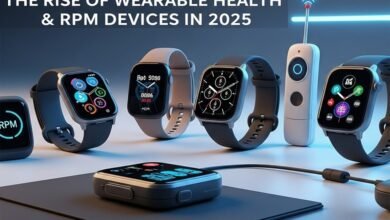Wearable Health Devices & Remote Patient Monitoring Devices: A Review and Comparison
The digital health landscape is evolving rapidly, and wearable devices combined with remote patient monitoring (RPM) systems have become essential tools for improving health outcomes and reducing costs. In this blog, we explore the latest technologies, their pros and cons, and highlight some leading devices and subscription models.
🔹 Emerging Trends
Advanced Sensing & Continuous Monitoring
Modern wearables now monitor far more than just steps and heart rate. Sensors track oxygen saturation (SpO₂), skin temperature, respiratory rate, ECG, and even stress metrics. Continuous monitoring enables patients—especially those with chronic illnesses—to detect health issues early and take action before emergencies occur.
AI & Predictive Analytics
Collecting data isn’t enough. Today’s devices use AI to analyze trends, identify patterns, and generate alerts when health deteriorates. For example, heart rate variability or glucose trends can predict arrhythmias or hyperglycemic episodes before they become critical.
Integration with Telemedicine
RPM devices now integrate with telehealth platforms, allowing doctors to view real-time patient data during virtual visits. This seamless connection ensures clinicians can make timely, informed decisions without waiting for in-person consultations.
Regulatory Standards & Privacy
As devices play a more significant role in medical decisions, accuracy, clinical validation, regulatory approvals (like FDA or CE mark), and data security are crucial. Patients and providers increasingly demand devices that comply with strict privacy and security standards.
Usability & Engagement
Battery life, comfort, and ease of use are central to device adoption. Wearables that are bulky or require frequent charging often lead to poor compliance. Features like gamification, reminders, and personalized dashboards help maintain patient engagement.
🔹 Pros & Cons
✅ Advantages
- Early Detection & Intervention: Chronic conditions like diabetes, heart disease, or COPD can be monitored continuously, reducing hospitalizations.
- Convenience & Accessibility: Patients can monitor their health from home, minimizing travel to clinics.
- Cost Efficiency: Reduced emergency visits and readmissions save significant healthcare costs.
❌ Challenges
- Accuracy Issues: Consumer-grade sensors may not match medical-grade equipment, leading to false positives or negatives.
- Integration Challenges: Data from different devices may not be compatible with clinician dashboards or EHR systems.
- Wearability & Battery Life: Devices that are uncomfortable or require frequent charging reduce patient adherence.
- Privacy & Regulatory Compliance: Protecting sensitive health data is essential, and some devices may not have full clinical approval.
🔹 Popular Devices & Subscriptions
Here are a few leading examples:
- Whoop 5.0 / WHOOP MG
Tracks ECG, heart rate variability, and blood pressure wellness features. Subscription includes hardware plus advanced analytics and performance insights. Battery life and app UI are highly rated. - Empatica Care + EmbracePlus
A smartwatch-like device that monitors vital signs and shares real-time data with care teams. Particularly useful for chronic condition monitoring and early symptom detection. - OneStep
Smartphone-based motion analysis platform monitoring gait and mobility. Clinician dashboards allow remote monitoring for rehab or fall-risk management.
These subscriptions usually combine hardware with cloud analytics, real-time alerts, and patient engagement features.
🔹 Choosing the Right Device
When selecting a wearable or RPM device, consider:
- Medical Validation & Approvals: Clinically tested and regulatory-approved devices ensure reliability.
- Health Metrics: Decide which metrics are most critical—basic vitals or advanced parameters like ECG or glucose monitoring.
- Integration: Can the device share data with your physician or health system efficiently?
- Comfort & Battery Life: Long battery life and comfortable design improve adherence.
- Cost & Subscription: Evaluate hardware costs plus monthly subscription fees for data storage and analytics.
🔹 Future Outlook
- Edge AI & On-Device Processing: Reduces latency, enhances privacy, and minimizes cloud dependency.
- Personalized Health Insights: AI-driven models will create tailored care plans based on individual patient data patterns.
- Embedded Wearables: Smart textiles and epidermal patches make monitoring less intrusive.
- Global Regulatory Harmonization: Simplifies device use across regions.
- Accessibility & Health Equity: Lower costs, offline functionality, and local-language apps improve adoption in remote areas.
🔹 Conclusion
Wearable health devices and RPM systems represent the future of healthcare. Choosing a device with accuracy, usability, integration, and a cost-effective subscription model can significantly improve chronic disease management, early detection, and overall healthcare efficiency. By staying updated with trends, prioritizing patient engagement, and ensuring regulatory compliance, patients and providers can maximize the benefits of these powerful technologies.



